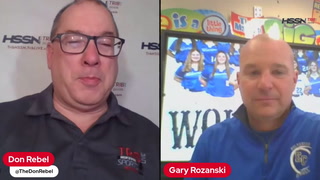Softball coaches walk line between winning and potential over-use of pitchers
By:
Wednesday, April 24, 2019 | 5:21 PM
While softball is different from baseball when it comes to pitchers’ throwing motion and wear and tear on their arms, a risk of over-usage still exists.
Latrobe might have found out the hard way.
Jordan Tallman threw 165 pitches against Yough earlier this season. The Wildcats sophomore has been near that total several other times. Tallman had to leave the Wildcats’ home game April 18, but it wasn’t because of an arm injury.
Coach Rick Kozusko said Tallman has an inflamed ligament in her plant leg and is out indefinitely, a crushing loss for a team that already dealt with the departure of former ace Kiley Myers, a Marist recruit who left the team four games into the season.
“Jordan was doing a great job for us,” Kozusko said. “As indicated by the stats.”
Of the 852⁄3 innings, Latrobe pitchers have worked, Tallman pitched 701⁄3 of them. She is 9-2 with a 1.39 ERA, 142 strikeouts and 27 walks.
Latrobe was short on experienced pitchers behind Tallman and Myers, so Tallman had to work overtime.
Kozusko wasn’t hellbent on using Tallman all day, every day. He likes to use multiple pitchers. Two years ago, he used three in one game.
“It provides rest for each over a long season where the pitcher is fresh for each start,” the coach said. “It allows a different pitcher to face a section opponent the second time playing, forcing them to adjust to a different set of pitches. It may foster healthy competition between the two where they can encourage each other to match or outdo their performance.”
So in an era when pitchers aren’t as dominating, does it pay to have a top pitcher throw every inning of every game? Is the over-use factor on the table?
Call to arms
For some teams, Latrobe notwithstanding, necessity beckons. One girl is far and above other pitchers. Some teams don’t develop pitchers like others.
Strikeout pitchers simply get the job done and allow their good-hitting lineups to operate more freely.
Class 5A No. 1-ranked Penn-Trafford (11-0) uses three pitchers: juniors Morgan Hilty and Sami Schickel and freshman Mia Smith.
Hilty has done most of the heavy lifting to back a heavy-hitting order.
“I use a 50-35-15 split (for appearances). I am an old baseball coach,” Warriors coach Denny Little said. “I believe in the pitching staff.”
Jeannette (6-2) has gone solely with junior Faith Johnston, who has started every game since the start of last season.
Sophomore Jess Matheny is Southmoreland’s workhorse ace. Franklin Regional rides with senior Angalee Beall.
More throw-strikes-to-get-outs pitchers have emerged since a significant rule change. They initiate contact and rely on their defense.
Hitter’s game
With the pitching circle back 3 feet — it was moved in 2011 — pitchers are working more to combat hitters. They have more room in which to make the ball move, with rise balls, change-ups and curves are often their best defense.
But the truth is, offense is up, no-hitters are down and at-bats are a lot longer.
Good pitchers could overpower hitters — in fewer pitches — before the circle was moved.
“It’s a hitter’s game now,” Mt. Pleasant coach Chris Brunson said. “The circle made all the difference.”
Class 4A No. 1 Mt. Pleasant (10-0) has one of the top pitchers in the WPIAL in Morehead State commit Carolyn Alincic. The senior has 88 strikeouts but has shared time in the circle with sophomore Mary Smithnosky. Overuse is not as much a concern for Brunson.
He stayed with Alincic in a nine-inning game when she struck out 20 on 125 pitches.
“I haven’t thrown Carolyn every game because we have the luxury of not having to,” Brunson said. “Some schools only have one pitcher, and that makes it tough. Carolyn is going to college to pitch. I want her to enter college healthy and fresh. During this stretch playoff push, I am sure we will be using her more.”
Brunson said coaches try to do their best when it comes to rest and relief with pitchers.
“I think most coaches are concerned with the health of their players,” Brunson said. “There are some girls that can pitch every game and some that are more effective with some rest in between starts. My opinion is make sure early in the season if a kid throws 100 pitches she has a couple days to recover before going back out. Once the kid is in good pitching shape and used to the workload, run them out there if they stay effective.”
Rest, risk and reward
Yough tried a different approach last year, “shutting down” standout hurler Kierra Waywood late in the season to rest her for the playoffs.
Karlie Clark filled in for the last two weeks of the regular season, but come the playoffs, “It did not work out for us,” Yough coach Dutch Harvey said. “I felt Kierra was not as sharp in the playoff games after the rest and struggled when put in pressure situations in those games.”
In 2016, when Yough won a PIAA championship, Harvey threw Macy Mularski repeatedly even though she had potential starters behind her.
“Macy pitched nearly every inning and was the type that loved the fact that she pitched every game and was upset when we gave another girl a game or innings,” Harvey said.
There is more to using two pitchers than the simple-sounding act itself, Harvey said.
“I feel that it is a luxury to have two quality pitchers,” he said. “But a lot of times, egos and parent involvement get in the way of the rotation, and in the end, it does cause issues. It takes two pitchers who want to work together and have no problem sitting while someone else takes the mound.”
That said, Waywood is Yough’s primary arm this season. She has 96 strikeouts and 10 walks, and averages 15.5 pitches per inning.
Travel effect
It could be argued pitchers are used to high pitch counts from summer softball. Harvey said he has seen girls throw upwards of 300 pitches in one day in travel ball.
“On a tournament Sunday, if you keep winning, you could play up to five or six games in a day and with most travel teams only having two top pitchers,” he said.
Another area coach, who might know pitching more than many, is Hempfield’s Bob Kalp.
“Throughout my career, I have seen most teams rely on one pitcher,” Kalp said. “If the team plays a weak opponent, then they will use their No. 2. I have had the luxury once or twice to have had essentially two No. 1s and could just basically alternate them.”
Kalp has been blessed with — and has helped to develop — tremendous pitchers over the years. He has noticed the travel ball effect.
“The abuse occurs when you play tournament ball and teams play three or four games in a day every weekend and rely on one pitcher to do the majority of the pitching,” Kalp said. “Most (high school) coaches are making sure that their pitchers get a day off every two or three days.”
Bill Beckner Jr. is a TribLive reporter covering local sports in Westmoreland County. He can be reached at bbeckner@triblive.com.
Tags: Hempfield, Jeannette, Latrobe, Mt. Pleasant, Penn-Trafford, Southmoreland, Yough
More High School Softball
• Trib 10: Baseball power rankings shaken up despite poor week of weather• Leechburg softball team proud to uphold playoff streak
• Westmoreland County softball notebook: Southmoreland captures elusive section title
• Close games sharpen Greensburg Central Catholic softball for battles ahead
• Trib HSSN softball player of the week for May 1, 2023







